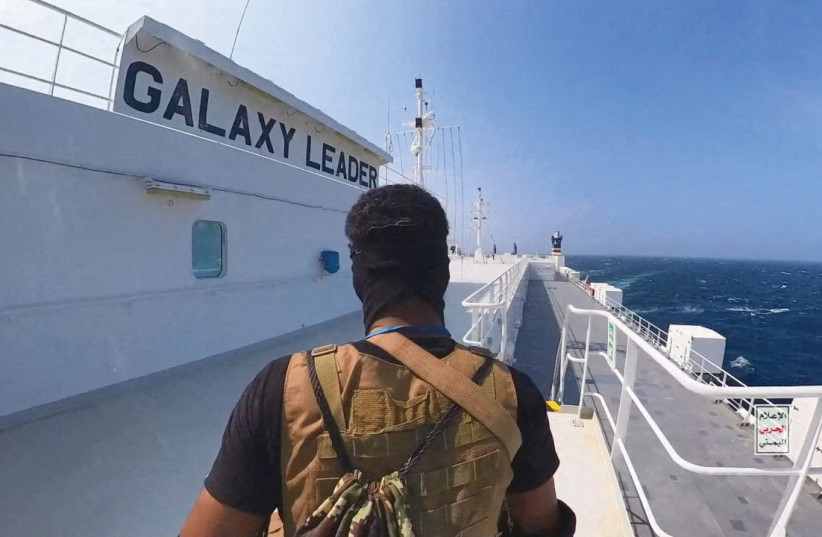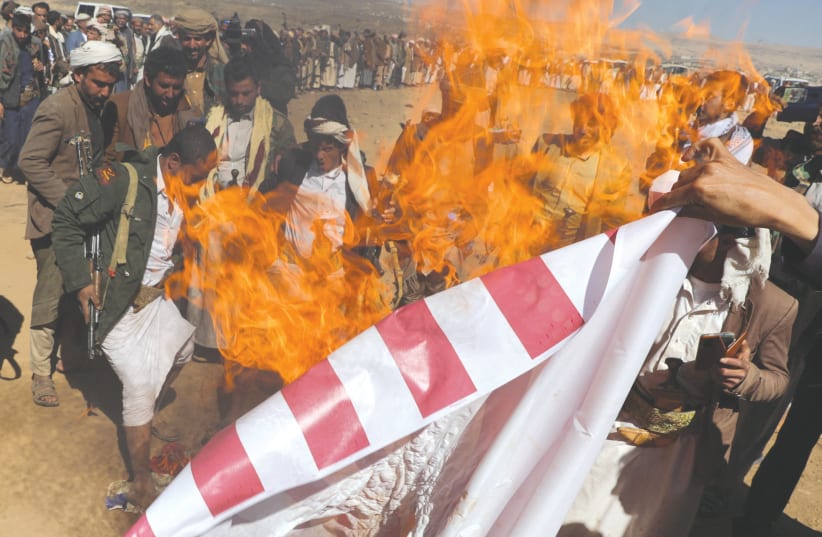Since the onset of the Gaza War, the Iran-backed Houthi rebels have significantly disrupted naval traffic around Bab al Mandab, intensifying their attacks on commercial vessels in the Red Sea through missile strikes, drone deployments, and hijacking activities.
Despite military interventions by the United States and United Kingdom targeting the Houthis weapon storage, the Houthi aggression persists.
Only a direct military response against the Islamic regime in Iran will effectively deter the regime’s aggressive tactics.
Mere attacks on the Houthis fall short; a more decisive action akin to Operation Praying Mantis of the past is necessary to prevent a repetitive cycle of aggression.
On December 13, 2023, missiles launched from Houthi-controlled areas were aimed at a cargo ship in the Red Sea, and a Houthi drone was shot down by a US warship during the same incident. Additionally, on November 19, 2023, the Houthis hijacked a cargo ship in the southern Red Sea, reportedly owned by an Israeli businessman, and diverted it to the port of Hodeida. On January 9, the Houthis launched a major barrage of missiles and drones towards international shipping lanes. The US reported that together with UK naval forces it had shot down 21 drones and missiles fired by Houthi rebels from Yemen in the southern Red Sea.


Spooked by the violence, major shipping companies including Maersk rerouted their ships around the Cape of Good Hope in Africa. More than 2,000 ships have so far avoided the Red Sea, causing weeks of delays in product shipping times. As expected, the price of commodities has gone up, with a barrel of crude oil rising to over $80. Rates on the Shanghai-Europe route rose 8.1% to $3,103 per 20-foot container, while the rate for containers to the unaffected US West Coast soared 43.2% to $3,974 per 40-foot container week on week.
Response of the Western world was too slow
The Western response was slow and hesitant. The US and its allies formed Operation Guardian of Prosperity to patrol the affected areas. According to a document from the European External Action Service (EEAS), the EU’s diplomatic arm, the bloc plans to create a new EU operation that would act in the Red Sea and broader Gulf waters by the end of February 2024. The United Nations Security Council (UNSC) adopted a resolution demanding the Houthis cease all attacks on ships flowing through the Red Sea.
The terror group ignored all the warnings, and, on January 9, launched the largest drones and missiles at the US and allied warships. With few other options, President Joe Biden authorized two strikes on January 11 and 12, respectively.
Altogether, more than 70 military targets in Yemen, which were used by Houthi rebels to endanger freedom of navigation in the Red Sea, were hit. However, the action in which the UK participated, was limited. According to the Joint Chiefs of Staff, only 20-30% of Houthi capability was destroyed. No Iranian personnel were hit. Reports on the deliberation leading to the decision indicated that the administration was worried that broader action would lead to a conflict with Iran.
The desire to avoid provoking the regime is seriously misguided and rests on a profound misunderstanding of how military theocracy operates.
The Houthis – along with Hezbollah, Hamas, Palestinian Islamic Jihad (PIJ), the Shi’ite militias in Iraq, and the pro-Iranian terror groups in Syria – are part of the Ring of Fire (Halgheye Atash), designed to surround Israel and protect the Islamic Republic from attacks on its nuclear facilities.
Because of their location, the Houthis were given a role in the Anti-Access/Area Denial (A2/AD), a plan to disrupt the key maritime checkpoints of the Straits of Hormuz, the Bab al-Mandab Straits, and the Straits of Malacca in the Indian Ocean.
Ayatollah Ali Khamenei, with guidance from the Iran Revolutionary Guard Corps (IRGC) Navy, known as NEDSA in Persian (Neyroy-e Daryaee Sepah Pasdaran), authored the document published in 2012 under the title “Strategic Triangle Maritime, Irregular Maritime Warfare” (Mosalath-e Estrategik-e Darayi, Jange-e Daryai Namonazam). It was a plan was for Iran to block the strategic passageways and disrupt the world economy in case of an attack on its nuclear program or oil assets.
Once the Houthis occupied a large swath of Yemeni territory, including the key port of Hodeida, the IRGC and the NEDSA poured considerable resources and equipment into upgrading their maritime capabilities. Promising Houthi fighters were trained in the elite Khamenei Academy of Naval Science and Technology in Ziba Kenar.
According to reports, a first group of Houthi cadets graduated in January 2020. Tellingly, some of the training took place on the Farur Island, a small, uninhabited island in the middle of the Persian Gulf, controlled by the IRGC. The regime had supplied the Houthis with an array of weaponry including ballistic missiles and drones, along with training, technological expertise, and equipment.
A limited attack on the Houthis is not likely to dissuade the Iranians from an aggressive policy of harassing ships and destabilizing the Red Sea region. In 2018, seeking to increase pressure on the regime, president Donald Trump withdrew from the Joint Comprehensive Plan of Action (JCPOA), prompting a debate about a response that divided the leadership.
Hardliners in the IRGC urged attacking American assets and its allies, but Ali Jafari, the IRGC chief, and then-president Hassan Rouhani cautioned that Washington would retaliate. They were overruled by the Supreme Leader who, under pressure from Qasem Soleimani, the powerful head of IRCG Quds Force, replaced Jafari with Hossein Salami in April 2019.
Salami, known for his fiery speeches against the United States, Israel, and Saudi Arabia, initiated an aggressive policy in the Gulf in 2019. In June, Iran shot down an American surveillance drone over the Straits of Hormuz. Despite threatening severe consequences, at the last moment, Trump aborted a strike against a handful of IRGC targets, such as radar and missile batteries.
Encouraged by the lack of response, two months later, IRGC ordered a Houthi attack on the Aramco Abqaiq-Khurais oil facility, the largest of its kind. The extensive damage produced a temporary 50% drop in Saudi oil production and destabilized world markets. Trump acknowledged that Iran was to blame but refused to intervene, stating that it was “a Saudi problem.” However, the aggressive policy of the Gulf continued and Soleimani was eliminated by an American strike in January 2020.
In the meantime, the IRGC and the Houthis have dramatically increased their maritime seizures and attacks in the Straits of Hormuz and the Red Sea. More consequential, the failure of deterrence has persuaded the Tehran regime that its hardline policy comes at no cost – a notion that swayed the balance of power toward Ebrahim Raisi and his coterie of radical officials.
The current situation should be compared to the Reagan administration policy during the waning days of the Iran-Iraq War.
Desperate to break the stalemate, Iran attacked tankers in the Persian Gulf and mined international waters. In April 1987, Reagan ordered Operation Praying Mantis, which destroyed oil rigs and damaged several Iranian vessels. In August, the then-supreme leader Ayatollah Khomeini accepted a ceasefire with Iraq, a decision he linked to drinking a “chalice of poison,” a reference to his adamant opposition to end the war.
Only a direct attack on the Islamic Republic can restore the deterrence necessary to curb the regime’s aggressive posture. Attacks on the Houthis are not enough. From the regime’s perspective, anything short of an attack along the lines of Praying Mantis would be just one more round in the “here we go again” game.
The writer is a senior fellow at the Philos Project.
